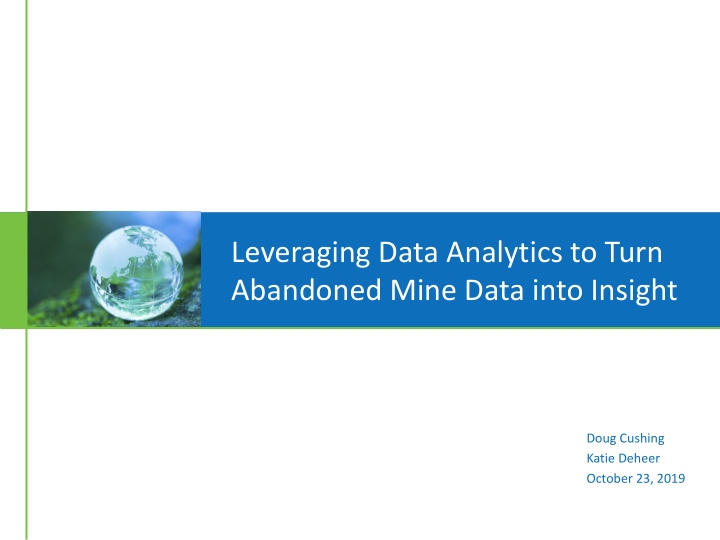



Leveraging Data Analytics to Turn Abandoned Mine Data into Insight Doug Cushing Katie Deheer October 23, 2019
Introduction • Doug Cushing, PE, PMP – Vice President of Digital Capital • Master’s degrees in Environmental Engineering and Information Systems 25+ years of experience with environmental and water engineering firms • Significant experience with EPA Superfund program and data analytics • • Katie Deheer, MBA – Manager of Advanced Analytics Master’s degree in Business Analytics • 10+ years of experience in business technology and analytics across multiple industries • 2
Setting the Stage • Analytics and Big Data are everywhere • Immense impact across industries • Data rich information rich (by default) 3
Applying Analytics to Environmental Data • Not in focus: • Multi-layer geospatial analysis • Alternative analysis of classic, high quality laboratory data • Classical statistics using Excel or statistical packages • In focus: • Teasing trends out of large, complex and often dirty or incomplete multidimensional data sets • Directional correctness, not transactional accuracy 4
Our Search for Data in Abandoned Mine Space • Bonita Peak Superfund Site • Colorado School of Mines • National Park Service • Publicly Available Abandoned Mine Land Databases • OSMRE • USGS • US Forest Service • State of Colorado • None of the above resulted in content for a powerful data analytics demonstration. • Not as large or robust • Better served by classic GIS or statistical techniques than data analytics 5
Demonstration of What is Possible • Data Set: Sanitary and Combined Sewer Overflows • Self reported – 1 state, 10 years, 20K events, NPDES data • First analysis on dirty data to understand major causes • Minor data cleanup • Conclusions were so strong, we needed to anonymize the data! 6
Demonstration
Demonstration 8
Demonstration 9
Demonstration 10
Demonstration 11
Demonstration 12
Demonstration 13
Demonstration 14
End of Demonstration
Call to Action Help agencies with their interest in utilizing data analytics at abandoned mine sites by identifying potential data sources that could be leveraged to turn information into insight. 16
Questions? 17
Thank you! Contacts: • Doug Cushing, CDM Smith, cushingdl@cdmsmith.com • Katie Deheer, CDM Smith, deheerk@cdmsmith.com • Anna-Marie Cook, EPA, cook.anna-marie@epa.gov • Stephen Dyment, EPA, dyment.stephen@epa.gov Citation of Demonstration Data: Talley, S., Salter, J., & Lee, W. (2016, December 30). [Sewer Overflow Data]. Published raw data. • To support anonymity around the contents of this database and the findings within, the reporting organization of this data set is not specifically named in this citation.
Recommend
More recommend